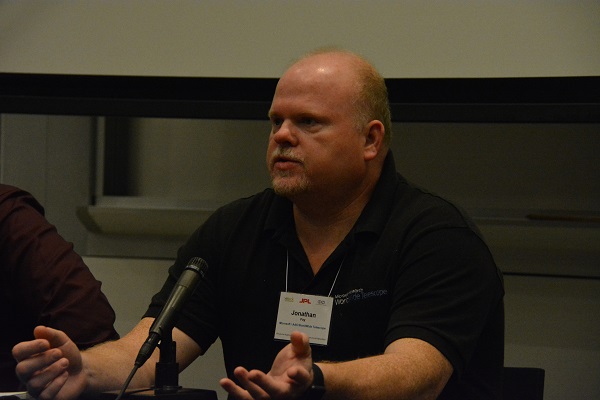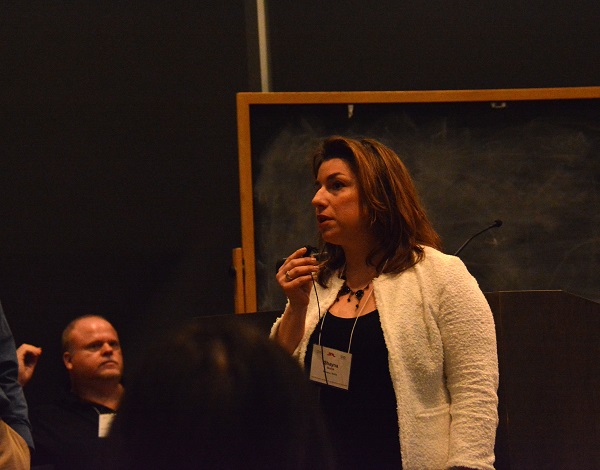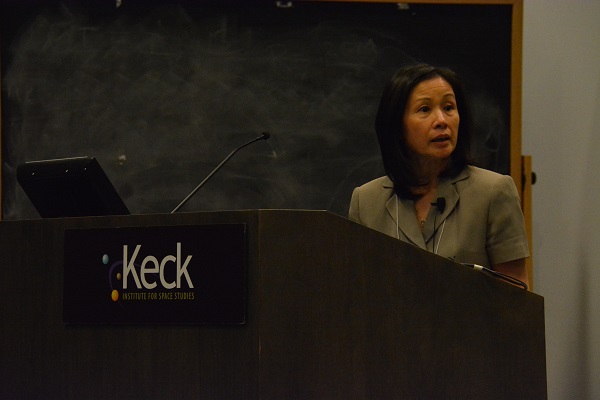by Dot Cannon
“Five years down the road, (virtual reality will be a part of everyday life),” said panelist Shayna Skolnik.
The day’s late-January Caltech symposium, on “Virtual and Augmented Reality for Space Science and Exploration”, had already been an intriguing one. Speakers had taken the Keck Institute for Space Studies stage throughout the day.
Among the topics explored: the use of VR in the arts, the ways AR facilitates the construction of spacecraft, and some of the issues that current prevent virtual reality from becoming mainstream.

And during breaks, participants had the opportunity to experience some of the new technology for themselves.
Now, the day’s final panel, “A View From the Industry and Tech Transfer”, was exploring the future.

Skolnik, who is the CEO and co-founder of Maryland-based technology company Navteca, pointed out the ways virtual reality translated complex data into understandable terms.

“In a typical (2D) perspective, we see the earth,” she said. “A lot of people lack this very, very basic understanding of the earth (including politicians, during a catastrophic weather event).”
“It took NASA data to allow viewers to fly down into a hurricane. (Now we can look at VR) as post-event analysis. Population data, insurance data and science data (will help us) be better prepared for future events.”
Where we’re going, where we’ve been

“It’s a fairly good assumption that the Web is not going to be 2D forever,” said Intradeco Apparel Director of Information Technology Eduardo Siman.
“What is the cursor for a 3D Web? Avatars.
“I think we can kind of start from the assumption that we’re going to have avatars that will be our cursors in the 3D Web.”
Siman offered his vision of the future virtual reality user experience.
“I think you’re going to…put on your headset…and…see something that looks like a bookstore. I work for an apparel company, and they ask, ‘how long do people spend in the apparel area?’.
“That’s what we’ll ask, but ‘how long do people spend in virtual reality?'”
The stars and the world
“When I first got into this, we were doing WorldWide Telescope,” said Jonathan Fay. Besides being the architect of the American Astronomical Society’s WorldWide Telescope, Fay is a principal engineer on Microsoft HoloLens .
“While we were one of the first astronomy applications, we still aren’t shipping in VR, many years later.”
Fay said the “missing piece” was a connection to users’ lives.
“What the virtual world should provide, (is) people’s experience and everything that they’ve trained with.”

“If you think about it, every journey in data starts out with data exploration,” said Virtualitics™ co-founder and CEO Michael Amori. (Virtualitics™, as described in the conference literature, is a Caltech-JPL startup on the intersection of data visualization, analysis and Virtual/Augmented reality.)
“In the real world, when we walk around the garden, we see the…position of the flowers, how they’ve moving. The same thing can be done with abstract data.
“If several avatars can be together inside a virtual office (for users in different parts of the world), they can explore complex data together and collaborate.”
VR’s transition to everyday life
“How do you give multiple people control without creating chaos?” asked moderator and program co-organizer Emily Law.

“We can have everyone be an active participant,” Amori responded. “We just (have to implement some ground rules), like in real life.”
Law, who is a Deputy Program Manager of Data Systems and Technology at Pasadena’s Jet Propulsion Lab, also explored one of the current obstacles to making virtual-reality more accessible to the general public.
“VR, right now, doesn’t scale very well,” she commented. “What kinds of pathways can science museums use, to access your content?”

“Think, how can you (prepare) users for the VR experience they’re going to have, and how can you send them home with some enrichment exercise,” Skolnik answered. “Five years down the road, (virtual reality will be a part of daily life).”

“One of the key things to transform planetariums–imagine setting up a few machines in a library or school,” Fay said.
“(Then, kids can put on a headset and) they’re popping out of a magic school bus with kids from all over the world, and interacting with them on a VR tour led by a planetarium employee.”

“If there’s a gravitational wave detection, I want to see it in VR,” said Siman. “The visualization, if you put it in any science museum, no one will stop to look at it.
“But if you put it in VR, (everyone will want to check it out.) Tell me, I’ll take my kids and we’ll go to see it.”
VR, hands-on
The day’s formal presentation ended with short demos of several recent projects. Among the virtual-reality products they showed the audience were Navteca and the World Wide Telescope.
Skolnik offered a look at the way Navteca took users inside Hurricane Matthew.
“You can walk around in the data, (and) use your hand to create the data slices scientists (use),” she explained.
Navteca’s work, Skolnik said, was about getting people comfortable with taking data a step further.
“We wanted to create something that lets people use something familiar to them, but to expand that functionality.”

“Writing about music is like dancing about architecture,” Fay commented, as he illustrated the ways VR experience enhances user understanding of data.
World Wide Telescope, he told his audience, was open-source.
“This environment, (in) VR, can become a completely different experience,” Fay commented. “The demo (has you) feeling like you’re sitting in nature.”

The audience applauded as symposium co-organizers Emily Law, S. George Djorgovski and Scott Davidoff wrapped up the program and thanked all the speakers.
For Law, Djorgovaki and Davidoff, thanks were forthcoming, as well.


Keck Institute for Space Studies Executive Director Michele Judd took the stage with a surprise gift for each, acknowledging all their hard work in organizing the day’s events.

And participants were invited to Caltech’s library for wine, cheese and some after-session VR demos.
Caltech’s “Virtual and Augmented Reality for Space Science and Exploration” had been a fantastic day.
And, as with most events on VR, AR and cutting-edge technology, the end was the beginning.
This is the conclusion of our special 4-part series. Read Parts 1, 2 and 3 here!

